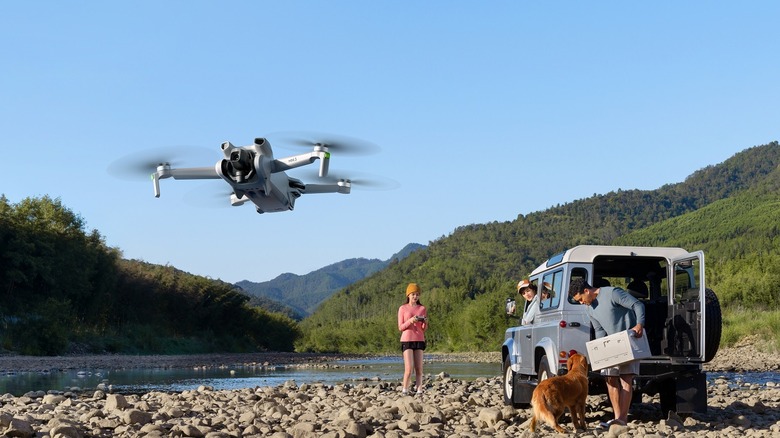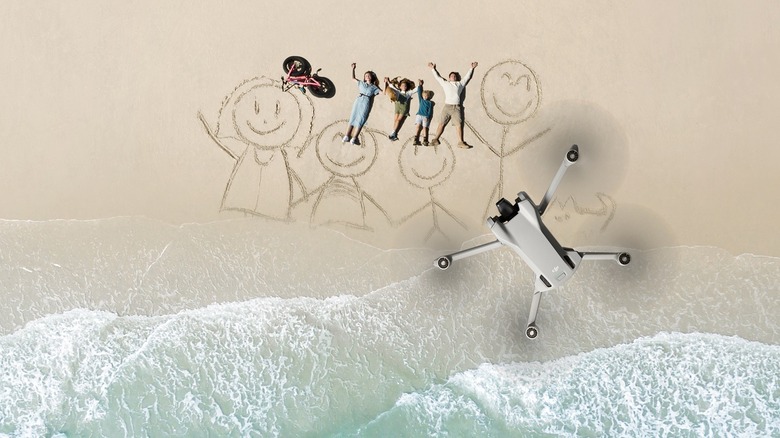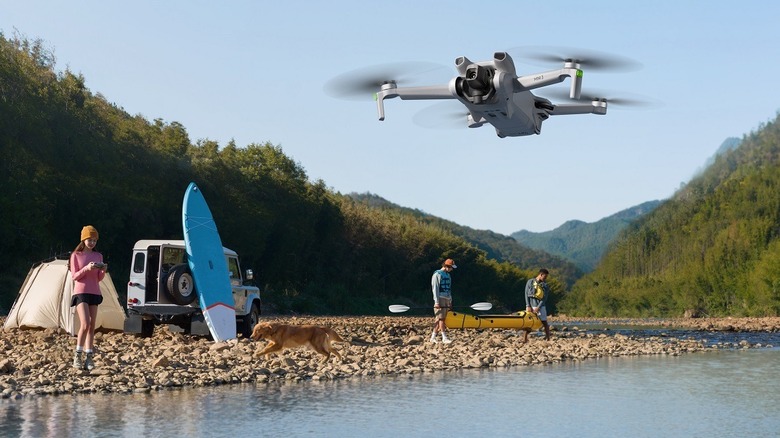DJI Mini 3 Drops The Pro's Best Feature But Gets A Lot Cheaper
DJI has been quite prolific with its drone launches in 2022. The company started the year by launching a new product from its famed "Mini" lineup — the DJI Mini 3 Pro — in May 2022. For those unaware, DJI's Mini drones come under the category of nano drones that weigh under 250g (0.55 pounds) to comply with FAA norms. A little over two months later, DJI came up with the DJI Avata — a compact FPV drone aimed at recreational users. In early November, DJI launched a scaled-down version of its flagship consumer drone series with the DJI Mavic 3 Classic. With a $1500 price tag, this drone was significantly cheaper than the Mavic 3 and the Mavic 3 Cine — both of them priced above the $2000 mark.
Today, DJI did something similar to its Mini lineup by launching a new model called the DJI Mini 3. In case you haven't figured it out already, the Mini 3 is a scaled-down (read: cheaper) version of the Mini 3 Pro that launched in May this year. However, the lower price tag means you lose out on a few features.
In the case of the DJI Mini 3, it loses out on the "Tri-Directional Obstacle Sensing" feature that debuted on the Mini 3 Pro. This feature made the Mini 3 Pro the first compact drone from DJI to feature forward, backward and down-pointing obstacle sensing capability. In addition, the cheaper Mini 3 loses out on the 48MP camera on the Pro model and uses a 12MP sensor instead. Thankfully, DJI has used the same sensor size on the DJI Mini 3.
DJI Mini 3: Key features
The DJI Mini 3 is roughly the same size as its Pro sibling and measures 148×90×62 mm with the propellers folded. While the maximum ascent and horizontal speeds for the drone are the same, the Mini 3 Pro has a slightly faster rate of descent. With a claimed 38 minutes of flight time, the Mini 3 can fly for four minutes longer than the Pro. With the Intelligent Flight Battery Plus mode selected, the flight time increases to 51 minutes and 47 minutes, respectively.
As discussed earlier, the camera on the DJI Mini 3 gets a 12MP 1/1.3-inch CMOS sensor mated to an f/1.7 lens. While supporting 4K resolution, the drone loses out on 4K 60 support. The video bit rate figures are also slightly lower than that of the Pro 100 Mbps as opposed to 150 Mbps). Another difference between the two drones is the lower video transmission resolution on the Mini 3 (720p) compared to 1080p on the Mini 3 Pro. Both drones use the same battery type, boasting a capacity of 2453 mAh. Like the Mini 3 Pro, the Mini 3 supports several Quick Take shots, including Dronie, Helix, Rocket, Circle, and Boomerang.
Pricing and availability
If you are a novice thinking of getting the DJI Mini 3 as your first drone simply because of its lower price tag, we recommend spending some more cash and getting the Pro variant instead. This is because the obstacle avoidance feature that you get for the extra cash can save you from potential crashes. Nevertheless, if you intend to buy the DJI Mini anyway, here are the pricing details.
Pricing for the DJI Mini 3 starts at $469 if you buy just the drone without a remote controller or a changer. For $559, users can get the drone and the DJI RC-N1 Remote Controller that requires a smartphone for POV flight. Customers also have the option to get the DJI Mini 3 with the DJI RC Remote Controller (that has a built-in touchscreen) — but that will cost them $699. Then there is the DJI Mini 3 Fly More Combo which includes a Shoulder Bag, a Two-Way Charging Hub, and two extra Intelligent Flight Batteries for $718. The second Fly More Combo option gets the same accessories — albeit with the DJI RC Remote Controller — and is priced at $858. The DJI Mini 3 goes on sale globally starting today at DJI.com and other outlets.


